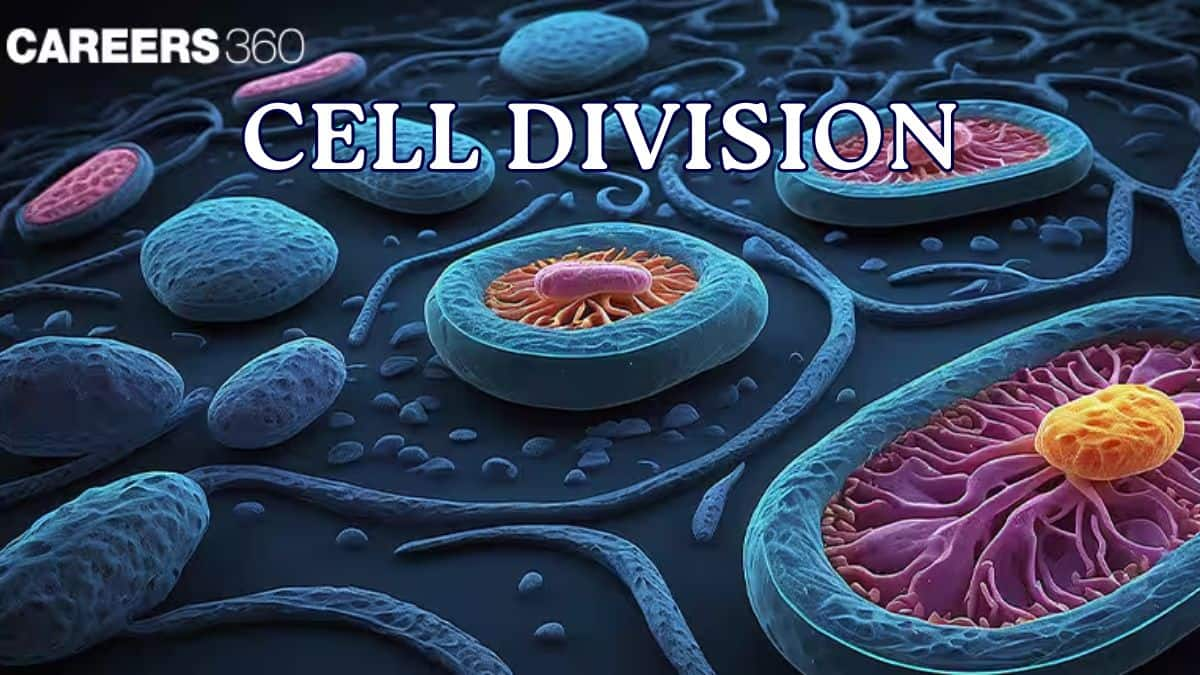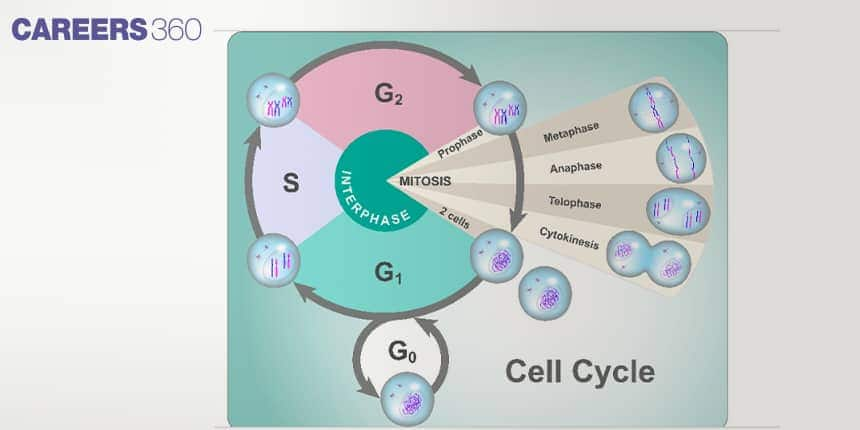Cell Division: Definition, Stages, Diagram, Phases and FAQ
Cell division is the fundamental biological process through which a single cell divides to form new cells for growth, repair, and reproduction. It includes mitosis (somatic cell division) and meiosis (gamete formation), both essential for maintaining life continuity and genetic stability. This topic is highly important for competitive exams like NEET and AIIMS B.Sc. Nursing, as questions are frequently asked from the chapter on cell division due to its fundamental biological significance.
This Story also Contains
- What is Cell Division?
- Types of Cell Division
- Cell Cycle and Its Phases
- Phases of Mitosis
- Differences between Mitosis and Meiosis
- Control and Regulation of Cell Division
- Significance and Applications of Cell Division
- NEET MCQs (With Answers & Explanations)
- Recommended video for Cell Division

What is Cell Division?
The cell cycle entails an ordered series of macromolecular events that lead to cell division and the production of two daughter cells identical to the parental cell.
Definition and Overview
Cell division is a process in which a parent cell divides to produce two or more daughter cells. Separation occurs such that, at the same time, the latter inherits the genetic material brought from the division. In other words, cell division is a basic process by which the organism is continuously developed, grown, and repaired.
Importance in Growth and Reproduction
Cell division for growth results in the increase of cell populations and an organism attains its final size. Primarily, successful regulation of the cell division process as an organism enables tissues and organs to differentiate into diverse functional units. Secondly, in restorative processes, for example, healing, cellular division of cells replaces damaged and lost cells in such a manner that tissue integrity is maintained.
Cell division is the essential mechanism by which all living things reproduce. It varies from organism to organism. In unicellular organisms, such as bacteria and yeasts, each cell division produces a complete new organism, whereas many rounds of cell division are required to make a new multicellular organism from a fertilized egg.
Types of Cell Division
There are two major types of cell division: mitosis and meiosis. Both processes involved in cell division hold a significant part in the life cycles of organisms, which is a potent tool for growth, reproduction, and adaptation.
Mitosis
Mitosis yields a division of somatic cells, therefore ensuring each daughter cell is a replica of the parent cell. It is very essential for the sustenance of tissues and the asexual reproduction of an organism.
Meiosis
Meiosis takes place in the respective speciality cells to form gametes with half the number of chromosomes in the parent cell. This process leads to sexual reproduction and genetic diversity in the offspring.
Cell Cycle and Its Phases
The cell cycle is the series of events through which a cell passes through cell division and duplication. It has four main phases:
G1 Phase (Growth 1)
The cell grows and performs all the proper cellular functions. It prepares for DNA duplication.
S Phase (Synthesis)
The chromosomes in the cell divide so that each of the two daughter cells will have the complete set of chromosomes.
G2 Phase (Growth 2)
The cell grows during this subphase, and it prepares for mitosis by synthesizing proteins and organelles.
M Phase (Mitosis)
The cell divides into two daughter nuclei. This process incorporates prophase, metaphase, anaphase, and telophase.

Phases of Mitosis
The four different stages of mitosis are:
Prophase
During this stage, the chromatin condenses and the chromosomes are visible.
The nucleolus disappears, and the nuclear envelope fragments.
With the disappearance of the nuclear membrane, the centrioles migrate to the opposite end, and spindle formation occurs.
Until prophase, the chromosomes have no particular orientation because the spindle has not yet formed.
Metaphase
Chromosomes become fully condensed and distinct.
Chromosomes move towards the equatorial plane of spindles or metaphase plates.
Chromosomes are arranged with their arms directed towards the pole and centromere towards the equator.
Anaphase
The centromere splits and the two chromatids of the duplicated chromosomes separate from each other.
Each chromatid now becomes a daughter chromosome.
Daughter chromosomes, each with a centromere and single chromatid, appear to move towards opposite poles.
Anaphase is the shortest phase of mitosis.
Telophase
During this phase, the spindle disappears and new nuclear envelopes develop around the daughter chromosomes.
Each daughter nucleus contains the same number and kinds of chromosomes as the original parent cell.
The chromosomes become diffuse chromatin and nucleolus reappears.
It is followed by the division of the cytoplasm.
Cytokinesis
Cytokinesis, the process by which the cytoplasm is cleaved in two, completes the M phase.
It usually begins in anaphase but is not completed until the two daughter nuclei have formed in telophase.
Cytokinesis in animal cells depends on a transient structure based on actin and myosin filaments, the contractile ring.
Differences between Mitosis and Meiosis
Both mitosis and meiosis hold a significant importance in cell division, but they differ in their mechanisms. The table below shows the differences between the two:
Mitosis | Meiosis |
It is known as the equational division. | It is known as the reductional division |
Mitosis is the process taking place in somatic cells. | Meiosis occurs in the germ cells, namely the sperm and ova cells, and is central to the process of sexual reproduction. |
It is the process of two successive cell divisions, resulting in four daughter cells. | It involves growth, tissue repair, and asexual reproduction. |
Since it forms two daughter cells, each having the same number of chromosomes i.e. diploid like the parent cell. | It results in four daughter cells, in which the number of chromosomes is halved i.e. haploid |
Control and Regulation of Cell Division
The process of cell division is very critical since strictly controlled and well-regulated pathways allow these processes to take place.
Cell Cycle Checkpoints (G1/S, G2/M, Spindle)
Among these checkpoints are the G1/S checkpoint, G2/M checkpoint, and spindle checkpoint—all regulating critical events and conditions that have to be checked off before entry to the next cell cycle stage.
Role of Cyclins and CDKs
Such checkpoints that delineate cell cycle progression are under the control of master regulators like the cyclins and CDKs. In this manner, their correct sequentiality ensures that the process of DNA replication is done properly to avoid mistakes that might eventually lead to genomic instability.
Significance and Applications of Cell Division
Cell division is an indispensable process for many different biological phenomena. It is prominently engaged in an increase in size, development, growth, tissue repair, regeneration, and asexual reproduction.
Growth and Development
Cell division with growth and development enables an organism to get bigger and more complex by the creation of new cells. This includes the differentiated ones.
Tissue Repair and Regeneration
In tissue repair and regeneration, cell division replaces damaged or lost cells and, therefore, restitutes tissue function and integrity.
Reproduction and Genetic Continuity
In asexual reproduction, the cell division helps in producing the offspring with a combination of genes that closely resembles its parent. It eventually assures rapid growth in population and survival under favourable conditions.
NEET MCQs (With Answers & Explanations)
Important topics for NEET exam are:
Types of Cell Division
Cell Cycle and its Phases
Mitosis and its Phases
Practice Questions for NEET
Q1. Interphase is
A phase in cell cycle
A phase in cell division
Both a and b
None of these
Correct answer: 1) A phase in cell cycle
Explanation:
All cells reproduce by dividing into daughter cells, and this process is known as the cell cycle. The cell cycle refers to an orderly set of stages that occur when a cell divides, and the daughter cells subsequently divide as well. It encompasses the sequence of events through which a cell duplicates its genome, synthesizes the necessary components, and ultimately divides into two daughter cells. The cell cycle is divided into two main phases:
Interphase: The phase where the cell grows, replicates its DNA, and prepares for division.
Division phase: This phase involves the actual process of cell division, which includes mitosis (or meiosis in reproductive cells) and cytokinesis, where the cell's contents are evenly distributed between two daughter cells.
These phases ensure that cells grow, function, and reproduce efficiently, maintaining the organism's cellular integrity.
Hence the correct answer is option 1) Interphase is a phase in the cell cycle.
Q2. Cell cycle is
An orderly set of stages that take place between a cell divide and then the daughter cells also divide
The sequence of events by which a cell prepares itself for division
Both a and b
None of these
Correct answer: 3) Both a and b
Explanation:
The cell cycle, a vital eukaryotic process, involves stages leading to cell growth and division. It's divided into interphase and mitosis. Interphase has three key phases: G1, where cells grow and produce proteins; S phase, when DNA replication occurs; and G2, for final preparations before division. Mitosis consists of prophase, metaphase, anaphase, and telophase, followed by cytokinesis. This process is tightly controlled by checkpoints and specific proteins to guarantee precise cell division and function.
Hence, the correct answer is option 3) Both a and b.
Q3. In a unicellular organism, cell division results in
Growth
Reproduction
Repairment
All of these
Correct answer: 2) Reproduction
Explanation:
The primary purpose of cell division in unicellular organisms is reproduction. These organisms are made up of a single cell, and when that cell divides, a new, autonomous organism is created. Binary fission, budding, or multiple fission are some of the mechanisms that enable this procedure, which is referred to as asexual reproduction. For example, in yeast, budding is the creation of a tiny bud that expands and finally separates, but in bacteria, binary fission results in the splitting of one cell into two identical daughter cells. numerous fission generates numerous daughter cells at the same time in certain protists, such as Plasmodium.
Hence, the correct answer is option 2) Reproduction.
Also Read:
Recommended video for Cell Division
Frequently Asked Questions (FAQs)
Mitosis consists of prophase, metaphase, anaphase, and telophase, culminating in cytokinesis.
The process of mitosis takes place within somatic cells and results in two identical diploid daughter cells, identical to the parent cell. Meiosis is a process that occurs in germ cells. It leads to four haploid daughter cells, each with its own, different genetic makeup.
Checkpoints known as G1/S, G2/M, and spindle monitor cell cycle progress, and proper cell division.
Errors in cell division can lead to various diseases and abnormalities, like cancer and Down syndrome.

